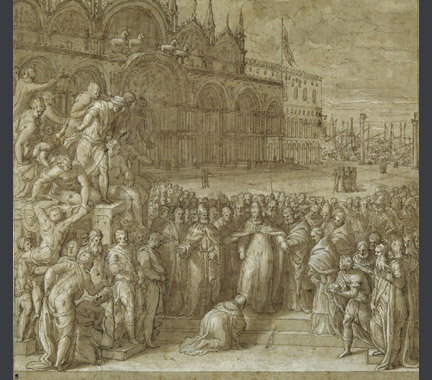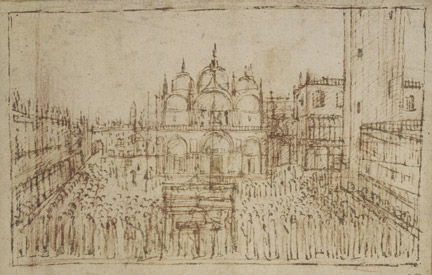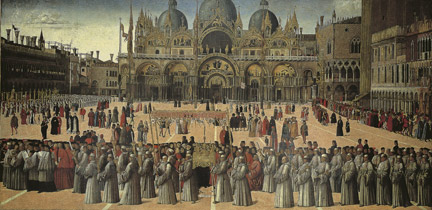Giuseppe Porta, called Salviati (early 1520s–about 1575)
'The Reconciliation between Pope Alexander III and Frederick Barbarossa, in the presence of Doge Sebastiano Ziani', 1563–5
Pen and brown ink with brown wash, heightened with white body colour, over preliminaries in black chalk on faded blue paper, faintly squared in black chalk, 35.4 x 37.7 cm
The Devonshire Collections, Chatsworth. © Devonshire Collection, Chatsworth. Reproduced by permission of the Chatsworth Settlement Trustees

Giuseppe Porta was trained in the Rome workshop of Francesco Salviati, whom he accompanied to Venice in 1539, remaining in the city when Francesco returned to Rome in 1541. Porta returned to Rome in 1562, but within three years he was back in Venice, where he died from the plague in or around 1575. Certainly by the early 1550s, and perhaps earlier, he began to sign his work ‘Salviati’, in memory of his absent master.
This drawing is a fully developed compositional study for part of Giuseppe’s most important work in Rome, the fresco decoration of the ‘Sala Regia’ in the Vatican, where the Pope received ambassadors. The subject of this sheet is an episode of medieval history which was central to Venetian state mythology – the humiliation of the Holy Roman Emperor Frederick I at the hands of Pope Alexander III, witnessed by Doge Alexander in the Piazza San Marco in 1177. Porta introduced contemporary elements into this historic scene, notably portraits of the reigning Pope Pius IV and of the reigning Doge Gerolamo Priuli. But the most important portrait in the drawing is of a place: Piazza San Marco.
Porta compresses the architectural space, the opposite approach to that taken by the 15th-century painter Gentile Bellini, in his drawing made in preparation for the painting ‘The Procession with the Relics of the True Cross’, painted for the Sala della Croce of Venice’s Scuola di San Giovanni Evangelista (figs. 1 and 2).


Gentile stressed the extensive space of the piazza in his final painting, and took a bird’s-eye view or at least a high viewpoint, looking down on the piazza and arranging the buildings either parallel to the picture plane for the Basilica di San Marco and the Doge’s Palace, or at right angles to it, as in the case of the Procuratie Nuove and Vecchie. Giuseppe Porta, on the contrary, chooses an oblique viewpoint, creating a diagonal sweep for the buildings, so that San Marco looms and dominates the setting, the upper arches of its façade rising up and beyond the limits of the picture. Its domes and deep structure are therefore out of sight, and the building is reduced to its façade. Nevertheless the façade is given depth, the embrasures of the porches emphasised by the multiplicity of engaged columns. Also, although the domes are invisible, five campanili appear above the top arches.
Porta seems to stretch out San Marco horizontally, turning it into a structure that partly blocks the view of the Doge’s Palace, almost as if he were seeking to celebrate the religious power of the Doge rather than his political status, or even the supremacy of the Church over secular authority (as is implied by the theme of the painting for which this drawing is a study).
The important ceremonial entrance to the Doge’s Palace – the Porta della Carta – is hidden and we only see the right half of the building. San Marco is meticulously rendered, its four bronze horses adopting a lively trot, and the mosaic stories in the lunette arches suggested in a loosely impressionistic manner. The diagonal sweep of the church is made even stronger by the massing of figures, piled up high in the left foreground, their strength enhanced by the height of San Marco. The figure group then performs almost the same diagonal sweep as the architecture, diminishing into deep space to the right. But the shape of the crowd is more complex than this, like a bow tie with the Pope positioned as the knot at its very centre, with the multitude spreading out in a triangular formation either side of him. The paving of the piazza behind mimics these diagonals. Throughout this drawing Porta is thinking about the relationship of figure to architecture and to space.
Piazza and Piazzetta
Porta’s most significant architectural decision was to minimise the distinctions between two adjacent – and connected – civic spaces. These are the Piazza San Marco, a very large east-west oriented space directly facing the façade of San Marco, and the Piazzetta, a smaller north-south oriented space, at right-angles to Piazza San Marco. The Piazzetta runs along the façade of the Doge’s Palace and faces the lagoon and the Molo (quayside), the key point of embarkation and disembarkation, of great civic and ceremonial importance for the public life of Venice. The fusion of the Piazza San Marco and the Piazzetta creates, as it were, an amalgam or shorthand view of Venice, which would have conveyed the essence of the city to those looking at it from afar in the Vatican.
Caroline Campbell and Amanda Lillie
Selected literature
Tietzes 1944, pp. 243–4; Boucher in London 1975, no. 717; McTavish 1981, pp. 322–3, fig. 223; Mortari 1992, pp. 174–5; Jaffé 1994, p. 119.
This material was published in April 2014 to coincide with the National Gallery exhibition 'Building the Picture: Architecture in Italian Renaissance Painting'.
To cite this essay we suggest using
Caroline Campbell and Amanda Lillie, ‘Giuseppe Porta, The Reconciliation between Pope Alexander III and Frederick Barbarossa, in the presence of Doge Sebastiano Ziani’ published online 2014, in 'Building the Picture: Architecture in Italian Renaissance Painting', The National Gallery, London, http://www.nationalgallery.org.uk/research/research-resources/exhibition-catalogues/building-the-picture/place-making/porta-reconciliation-between-pope-alexander-and-frederick-barbarossa
